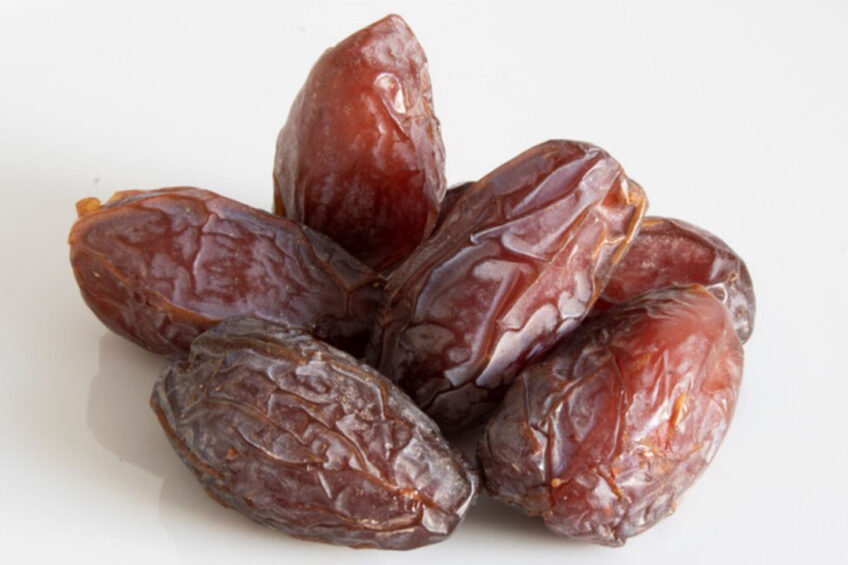Effect of date pits on aflatoxin B1 in broilers

Date pits, a by-product of the date palm processing industry, protects broilers against aflatoxin B1, a new study in the journal Agriculture reveals.
Mycotoxins, including aflatoxins, are currently regarded as threatening in poultry. Among the various kinds of aflatoxins, aflatoxin B1 (AFB1) is the most predominant and toxic for poultry.
Risks to poultry
AFB1 is converted into secondary toxic metabolites chiefly in the liver, causing liver injury and alterations in hepatic function. Numerous studies have demonstrated the harmful influences of AFB1 in broiler chickens, involving a decrease in growth responses, changes in carcass quality, liver damage, a poor immune response, enhanced susceptibility to infectious diseases, and augmented mortality, leading to considerable financial losses. Furthermore, AFB1 residue in edible tissues is a possible risk to human health.
Potential of agricultural wastes
Agricultural wastes, which are sources of beneficial phytochemicals, have been examined for their antimicrobial ability and several studies have demonstrated that polyphenols from various sources have the potential to reduce the concentration and toxicity of aflatoxin B1. Date pits (DP), which comprise roughly 10% of the date’s weight, are a by-product of the date palm processing industries. In recent years, some research reports have shown that date pit meal can be used as an alternative feed ingredient in poultry rations. Nevertheless, the researchers found that there was limited knowledge of the use of date pits as a mycotoxin adsorbent in broiler chickens.
Date pits study
This research evaluated the toxic influence of dietary AFB1 (0.25 mg/kg) and the ameliorative efficacy of date pits as a dietary adsorbent (inclusion levels: 2% and 4% DP) on growth performance, carcass characteristics, ileum morphology, nutrient digestibility, and liver AFB1 residues. Broilers (Ross 308) were randomly allocated to 6 dietary treatments, with 10 replications of 6 birds each, in a 20-day experiment.
The dietary treatments were as follows (diets 3 and 4 are not included in this report as they did not differ substantially from diet 1):
Diet 1: Negative control (NC): uncontaminated diet
Diet 2: Positive control (PC): NC + 0.25 mg/kg AFB1
Diet 3: NC + 2% DP
Diet 4: NC + 4% DP
Diet 5: PC + 2% DP
Diet 6: PC + 4% DP
Growth performance and carcass yield
Several prior experiments have demonstrated the detrimental impact of AFB1 on the growth performance and carcass characteristics of broilers. In the current study, broilers fed a diet naturally contaminated with AFB1 had significantly reduced feed intake, reduced weight gain, lower production efficiency factor (PEF) and higher FCR during the experimental period, along with less dressing and breast meat yields compared to those provided with the uncontaminated diet (Table 1). Feeding the contaminated diet (positive control) in this study reduced ileal villus height (VH) and villus surface area (VSA) in the ileal mucosa, reduced the digestibility of CP and EE, and reduced energy levels (AME and AMEn).
This compromised growth performance was related to the impairments of AFB1 on epithelial cell proliferation and protein synthesis in the small intestine, which could, in turn, reduce nutrient digestibility. The dressing percentage and breast meat yield reduced by AFB1 were improved by the addition of date pits at both the 2% and 4% inclusion levels. It was concluded that the AFB1-induced impairments observed in both liver function and intestinal integrity contribute to reduced growth rate and carcass yield of broilers. The researchers also identified the ability of mannan-oligosaccharides in date pits to reduce the negative effects of AFB1.
Antioxidant status of broilers
The results of the study showed that broilers given the AFB1-contaminated diet had significantly lower levels of antioxidant enzymes and total antioxidant capacity compared to uncontaminated feed. The metabolites of AFB1 cause cellular oxidative stress through increasing lipid peroxidation reactions, possibly leading to the inhibition of serum antioxidant enzyme activities. In addition, reduced protein biosynthesis due to AFB1 can be held accountable for lower enzyme activities. The addition of date pits improved the antioxidant capacity of broilers, as shown by higher levels of antioxidant enzymes (superoxide dismutase and glutathione reductase) and total antioxidant capacity value.
Nutrient digestibility
The addition of date pits at both inclusion levels (2% and 4 %) improved the apparent nutrient digestibility of protein (CP) and fat (EE) and improved energy retention (higher AME and AMEn) in broilers, showing its high binding capacity to AFB1 molecules. Higher positive ileal modulative effects of date pits were observed as higher ileal villus height (VH) and total villus surface area (VSA), compared to the AFB1-contaminated diets.
Liver function
The toxicity of AFB1 has been shown to trigger the suppression of hepatic protein, carbohydrate, and lipid metabolism, and might therefore lead to liver enlargement and serum biochemical changes. This study showed that, together with an enlarged liver, serum glutamic oxaloacetic transaminase and glutamate pyruvate transaminase concentrations and residual levels of AFB1 are significantly elevated in broilers fed the AFB1-contaminated diet.
This finding is in accordance with former studies on broiler chickens regarding transaminases activities and AFB1 residues in the liver, illustrating the fact that the accumulation of AFB1 in the liver could trigger apoptosis and inflammation in broiler hepatocytes. During aflatoxicosis, AFB1 is chiefly metabolised in the liver, and its secondary metabolite of AFB1-8,9-expoxide can attach to cellular macromolecules, such as proteins, lipids, and nucleic acids, bringing about hepatocyte cancerisation and liver damage. When hepatocyte permeability increases following liver injury, transaminases could be liberated from the infected hepatocyte into the bloodstream and elevate the serum activity of transaminases, including glutamic oxalacetic transaminase and glutamic pyruvic transaminase enzymes that were elevated in the AFB1 diet. The residual AFB1 in the liver for the contaminated diet was 3.32 µg/kg but was reduced by 1.23 and 1.02 µg/kg as a result of the addition of date pits at 2% and 4%, respectively.
Conclusion: Benefits for poultry
The researchers concluded that dietary AFB1 at a dose of 0.25 mg/kg reduced growth efficiency, deteriorated carcass yield, altered serum biochemical metabolites, caused liver injury, depressed antioxidant capacity, impaired ileal architecture, and diminished nutrient digestibility in broilers. On the other hand, a dietary supplementation of 4% DP provides good protection against the detrimental influences of AFB1 on the productive and health indicators of the birds.











